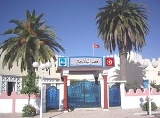
Tebourba
Encyclopedia
Tebourba is a town in Tunisia
, located about 20 miles (30 km) from the capital Tunis
.
, 44, and the Tabula Peutinger. Situated on a hill, the city occupied only a part of the ancient site, when it was rebuilt in the fifteenth century by the Andalusian Moors. The Roman amphitheatre was still standing at the end of the seventeenth century, when it was destroyed to build a bridge. The nearby Thuburbo Maius is in ruins.
As a diocese it was a suffragan of Carthage
, and it is now a Catholic titular see
. It was at Thuburbo Minus that the Christian martyrs Perpetua and Felicity with their companions were arrested. The two known bishops of this city are: Victor, present at the Conference of Carthage (411), where he had as his competitor the Donatist
Maximinus; and Germanus, who signed (646) the letter of the bishops of the proconsultate to the Patriarch Paul II of Constantinople
against the Monothelites.
of the Second World War, lasting from November 29 until December 4, 1942. The battle involved the troops of the US and British armies against the German army.
The British and Americans held the town for several days until it fell to the Germans on December 4.
The battle is commemorated in the name of a road in Southampton, England called "Tebourba Way." There is a small war memorial on the roadside at the junction with Oakley Road. Tebourba Drive in Alverstoke, Gosport is also named after the battle.
Tunisia
Tunisia , officially the Tunisian RepublicThe long name of Tunisia in other languages used in the country is: , is the northernmost country in Africa. It is a Maghreb country and is bordered by Algeria to the west, Libya to the southeast, and the Mediterranean Sea to the north and east. Its area...
, located about 20 miles (30 km) from the capital Tunis
Tunis
Tunis is the capital of both the Tunisian Republic and the Tunis Governorate. It is Tunisia's largest city, with a population of 728,453 as of 2004; the greater metropolitan area holds some 2,412,500 inhabitants....
.
Thuburbo Minus
Historically Thuburbo Minus was a settlement in Africa Proconsularis, located at present-day Tebourba. Thuburbo Minus is mentioned in the Antonine ItineraryAntonine Itinerary
The Antonine Itinerary is a register of the stations and distances along the various roads of the Roman empire, containing directions how to get from one Roman settlement to another...
, 44, and the Tabula Peutinger. Situated on a hill, the city occupied only a part of the ancient site, when it was rebuilt in the fifteenth century by the Andalusian Moors. The Roman amphitheatre was still standing at the end of the seventeenth century, when it was destroyed to build a bridge. The nearby Thuburbo Maius is in ruins.
As a diocese it was a suffragan of Carthage
Carthage
Carthage , implying it was a 'new Tyre') is a major urban centre that has existed for nearly 3,000 years on the Gulf of Tunis, developing from a Phoenician colony of the 1st millennium BC...
, and it is now a Catholic titular see
Titular see
A titular see in various churches is an episcopal see of a former diocese that no longer functions, sometimes called a "dead diocese". The ordinary or hierarch of such a see may be styled a "titular bishop", "titular metropolitan", or "titular archbishop"....
. It was at Thuburbo Minus that the Christian martyrs Perpetua and Felicity with their companions were arrested. The two known bishops of this city are: Victor, present at the Conference of Carthage (411), where he had as his competitor the Donatist
Donatist
Donatism was a Christian sect within the Roman province of Africa that flourished in the fourth and fifth centuries. It had its roots in the social pressures among the long-established Christian community of Roman North Africa , during the persecutions of Christians under Diocletian...
Maximinus; and Germanus, who signed (646) the letter of the bishops of the proconsultate to the Patriarch Paul II of Constantinople
Patriarch Paul II of Constantinople
Paul II was the Ecumenical Patriarch of Constantinople from 641 to 653. He assumed regency for Byzantine emperor Constans II after a succession crisis in 641....
against the Monothelites.
World War II
Tebourba was the location of a battle in the Tunisia campaignTunisia Campaign
The Tunisia Campaign was a series of battles that took place in Tunisia during the North African Campaign of the Second World War, between Axis and Allied forces. The Allies consisted of British Imperial Forces, including Polish and Greek contingents, with American and French corps...
of the Second World War, lasting from November 29 until December 4, 1942. The battle involved the troops of the US and British armies against the German army.
The British and Americans held the town for several days until it fell to the Germans on December 4.
The battle is commemorated in the name of a road in Southampton, England called "Tebourba Way." There is a small war memorial on the roadside at the junction with Oakley Road. Tebourba Drive in Alverstoke, Gosport is also named after the battle.

